Water Birds of Rio Lagartos, Yucatan
 Rio Lagartos is a small town on the north coast of Mexico's Yucatan Peninsula,
not far from the flesh pots and gaudy lights of Cancun.
Rio Lagartos is a small town on the north coast of Mexico's Yucatan Peninsula,
not far from the flesh pots and gaudy lights of Cancun.
Rio Lagartos might be physically close to Cancun, but in spirit it's about a million miles away. It's positioned at the western end of the Rio Lagartos Biosphere Reserve, a large coastal mangrove forest with saltwater channels, shallow sea grass flats, sand bars and salt pans. You can stay in Rio Lagartos overnight, and in the morning you hardly need to go past the shorefront to start your bird watching. Here's a ruddy turnstone on one of the town's docks, with the latest in fashion accessories - a piece of sea grass wrapped around its leg! It's already in breeding plumage, but maybe it felt it needed a bit of help to get a mate. Ruddy turnstones are very widespread, found all the way from North America to Europe, Africa, Asia, throughout the Pacific and down to New Zealand. |
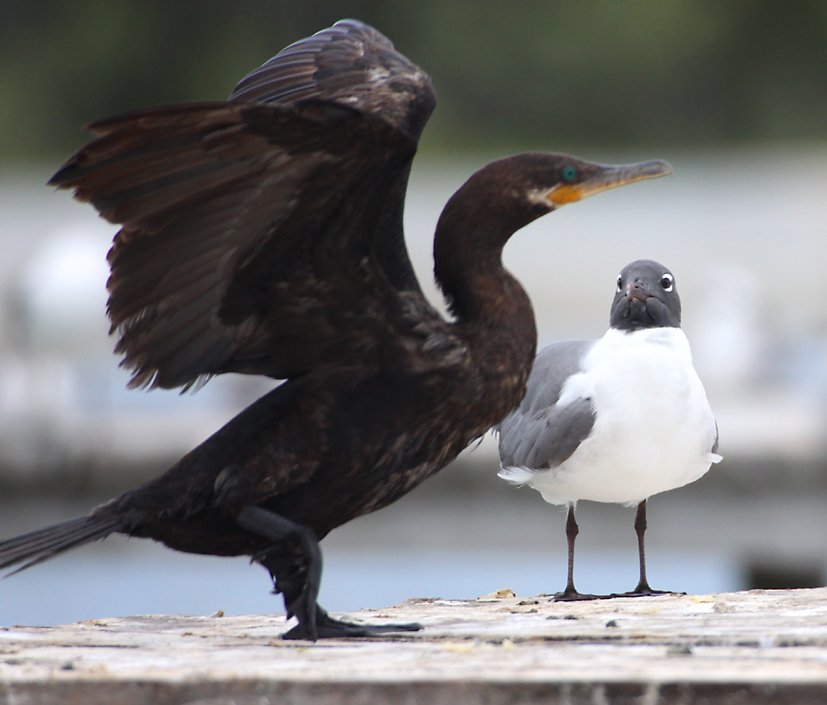 There's plenty to see on the dock, and it's not just people who do the
watching!
There's plenty to see on the dock, and it's not just people who do the
watching!
Here's a laughing gull curiously watching a double-crested cormorant's morning callisthenics. |

The gull has plenty of interesting critters to watch, like this black skimmer. The skimmers are the only family of birds in the world whose bottom bill is longer than the top. They have this arrangement to allow them to fly just above the surface off the water, with their lower bill skimming the surface, which snaps shut as soon as they hit a fish. You can see a black skimmer in action over the Bolsa Chica nature reserve in Los Angeles. As you can see, black skimmers have very undersized legs and feet to make it easier to fly low over the water. Small feet are also less weight to carry around, a characteristic taken advantage of by other aerial masters like tropicbirds. The way the skimmer's black eye is entirely within the black hood on its head adds to its comical appearance, but what's more unusual is its catlike vertical pupil, which is unique among birds. |

It's enough to make a laughing gull do what it does best - laugh! |

Actually, laughing gulls are pretty good at a few other things, too! All the laughing gulls on this page are adults, young birds don't have the black hood, and the adults themselves mostly lose the hood in winter. |
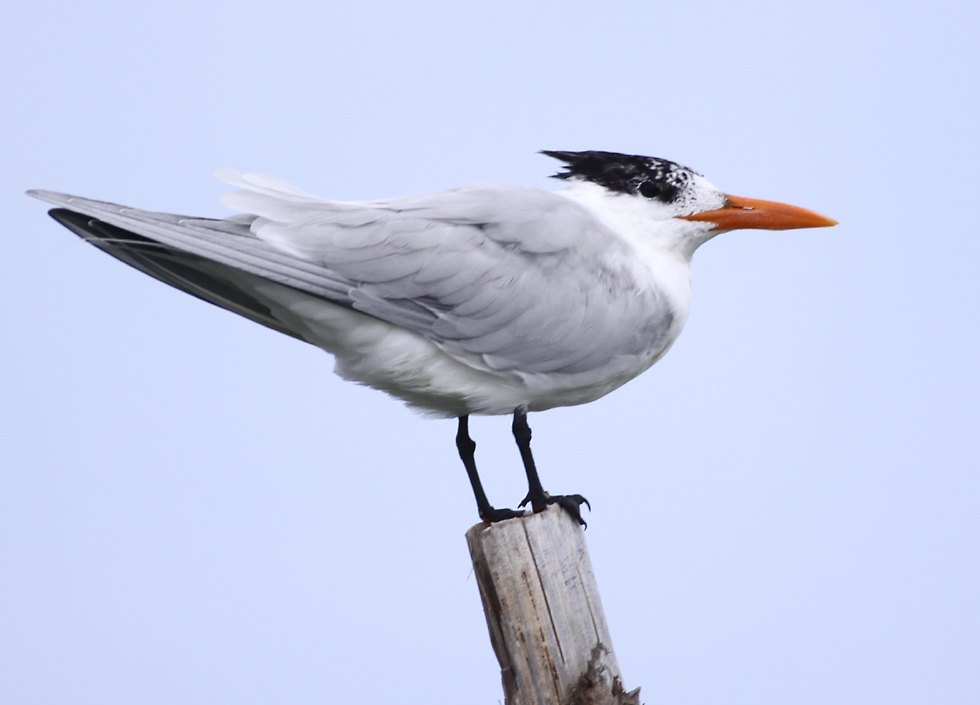
Laughing gulls are scavengers and omnivores, but caspian terns like this one are the real masters of fishing, hovering over the surface and then diving in. It's the largest of all terns. Like the ruddy turnstone it's very widespread, however there are only 50,000 breeding pairs in the world. |

This brown pelican is much larger than the tern, but it uses the same basic approach to fishing, watching for fish from high above and then diving into the water to reach them. It's the only pelican species which does this, the others swim together on the surface and just plunge their beaks into the water. Unlike the tern, brown pelicans don't precisely spear or grab their prey, instead they engulf a large quantity of water (and hopefully fish) in the huge pouches under their beaks. This pouch can hold about 10 liters of water; since the stomach can only hold about 3 liters, the poet was quite right when he wrote: A curious bird is the pelican/His beak can hold more than his belly can/He can hold in his beak/Enough food for a week/But I wish I knew how the hell he can. This is a juvenile, but if you want to see an adult male in breeding plumage then just take a look at the bird banner in the very top, right-hand corner of this page! |

As well as using the town's docks, the local waterbirds also take advantage of the local fishing boats, resting on the masts and leaving little gifts of love and appreciation for the fishermen. These are double-crested cormorants, an adult in front and a juvenile behind. Their webbed feet aren't too great at perching, but they make do with any small flat surface they find. |

Another double-crested cormorant. They only have crests during breeding season, but they're fairly recognizable by the yellow skin under their bill and their green eyes. This one's bill is fairly light-colored, which means that it's probably a juvenile. |

This is an anhinga, which is very similar to a cormorant, but actually belongs to a family of birds called darters. In English, anhingas are also sometimes referred to as water turkeys, American darters or snakebirds. This last name supposedly comes from the snake-like appearance of its neck and head, the only parts visible above water when it's swimming. The one you see here is a female, easily distinguished by its tan plumage from the male, whose base plumage is entirely black, but whose wings have a similar black-and-white pattern to the female. |
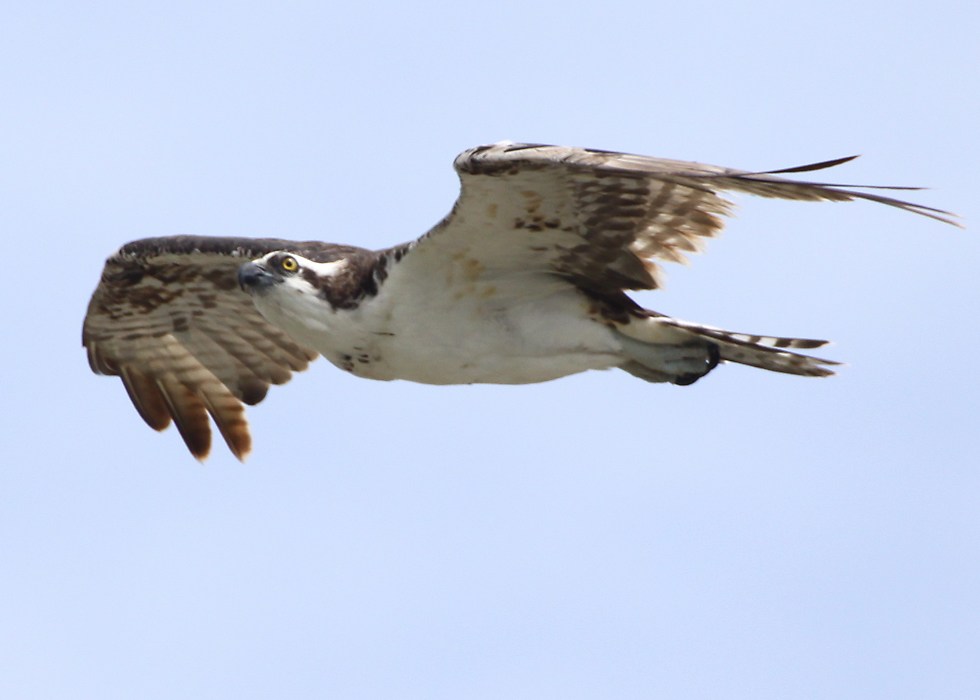
Diving under the surface is a great way to hunt for hard-to-reach fish, but there are other birds which make do by snatching fish from the surface. We've already seen the skimmer, whose approach is fairly unique. There are also several raptors which use their talons to catch fish, usually without getting too wet. The most famous of these fishing raptors is the bald eagle, however the consummate example is the osprey, shown here. The osprey is so successful that it has spread almost entirely around the world. The osprey isn't an eagle or even a hawk, instead it belongs to a family by itself. Unlike other fishing raptors, it can actually go underwater to a depth of about a meter. It dives feet first, and can close its nostrils to prevent water entering. It's the only bird of prey which can reverse the direction of its outer toes, which allows it to grasp a fish with two claws on each side. They usually hold the fish so it's facing forwards, which reduces drag and makes it easier to fly. |

Here's another raptor, a common black hawk. They mainly eat crabs, but as you can see they're not averse to snatching a fish off the surface of the water. Adults are quite a bit smaller than ospreys, so it wasn't surprising when the osprey in the previous photo swooped down and harassed a common black hawk which was minding its own business perched on a tree. |
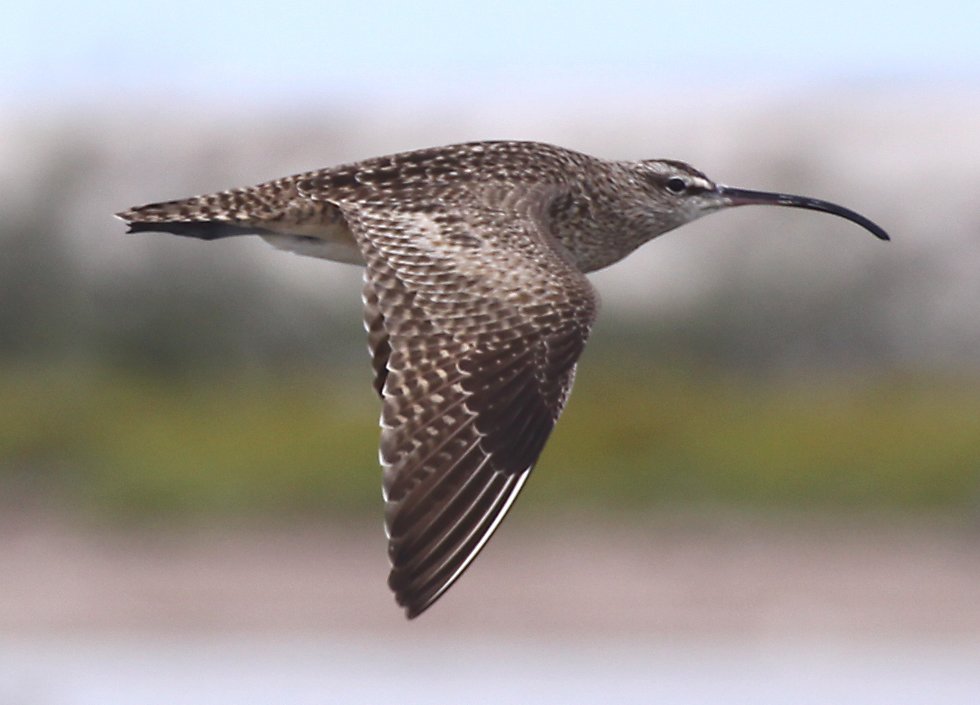
Skimming, snatching and diving are all very well, but most of the water birds at Rio Lagartos prefer wading. This whimbrel belongs to a family of eight birds called curlews, all of which have curved bills. Compared to the other birds on this page, the beak is very slender and lightweight, which gives a clue that whimbrels eat small crabs and other crustaceans, rather than fish. |
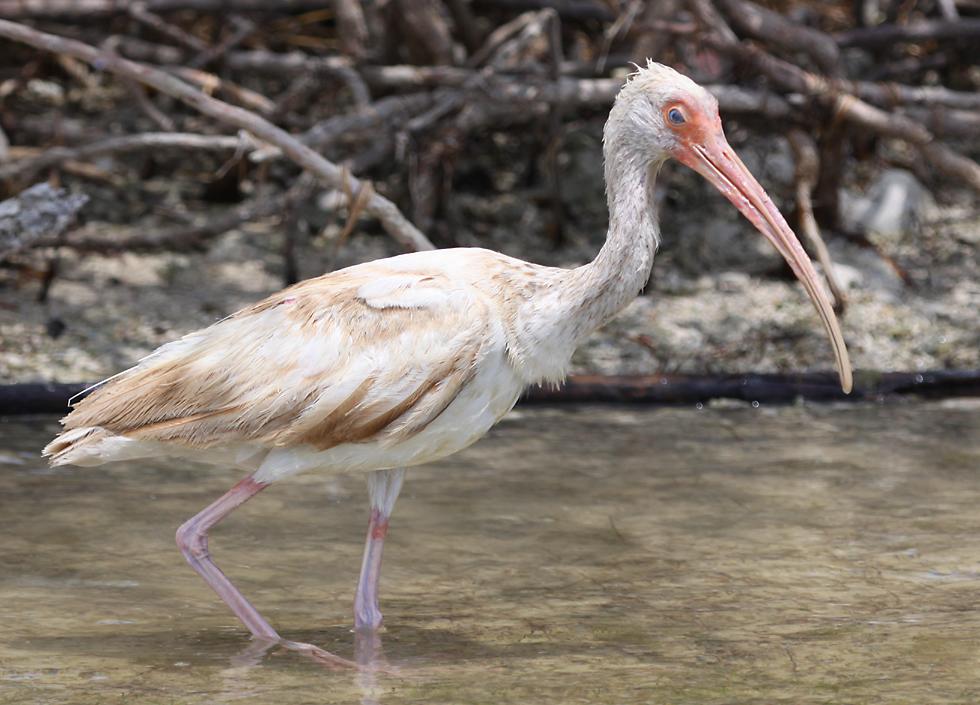
Ibises are another family of wading birds with curved beaks. This is a juvenile white ibis which is well on its way changing from its initial brown plumage to the all white plumage of an adult. Like the whimbrel, the white ibis also eats crustaceans like crabs and crayfish, rather than fish. Both birds are certainly too small to eat the many adult horseshoe crabs which can be seen in the shallow sea grass flats of the preserve, though they can probably handle very young horseshoe crabs. Since these crustaceans eat a lot of fish eggs, waders like the whimbrel and white ibis actually benefit the fish population. In this photo you can see the ibis' nictating membrane drawn half-way across its eyeball. The nictating membrane is sometimes referred to as a third eyelid, though it moves horizontally across the eye, rather than vertically like the top and bottom eyelids. Many different types of vertebrates have nictating membranes, including birds, marine mammals, reptiles and sharks. |

Rio Lagartos plays second fiddle to the more famous bird sanctuary on the north-west coast of Yucatan at Celestun. However, in many ways Rio Lagartos is a better place to visit. Not only is it much closer to the main tourist centers on the east coast, but it's also far cheaper. I paid $US40 for a three hour private boat tour. The guide was licensed and very knowledgeable about birds, and very helpful when it came to getting me photos. For instance, on our way out to the main channel, a flock of about 15 cattle egrets started approaching us from the shore. The guide matched their speed, about 80 meters to one side and then rapidly slowed the boat to allow me to get a photo. He repeated this about three times, and to my amazement I actually managed to get a few useable shots. Throughout the tour he went out of his way to get me into a good position, while still respecting the birds' need for peace and quiet. The reserve is quite a good place to take photos, though of course it's never easy to do this from an unstable platform like a small boat. However the main channel and the shallows are sheltered from the worst of the wind by the mangrove forest and sand dunes. |

I like the plumage of the cattle egret, but I always feel like there's something artificial when I see one in the Americas. Its natural range is Africa, Europe and Asia, but in 1877 it was found in the north-eastern part of South America. It is thought to have crossed the Atlantic on its own, though I can't help thinking that it might have had some mid-trip assistance from people, in the form of a necessary rest on a ship or ships. There's a minimum separation of 2750 kilometers between Africa and South America, which is an awful long distance for such a bird to fly, especially since it would be going against the prevailing winds. One factor which certainly assists its spread is the farming of cows and other grazing animals by humans, since the cattle egret mostly feeds by following such animals and eating the insects they disturb in the grass. They'll even follow farm machinery for the same reason. There certainly aren't any grazing animals at Rio Lagartos, and it's hard to imagine the tough leaves of the mangrove forests supporting many insects. This makes it hard for the cattle egrets, especially since they've lost the ability of most wading birds to compensate for the refraction of the water's surface when hunting fish or frogs. Although called an egret, the cattle egret is actually more closely related to herons. It differs from most egrets and herons in being most at home in dry, grassy habitats. |

The bird on the right here is a snowy egret, easily recognizable by its black beak, black legs and yellow feet. I'm assuming that the one on the left is an immature snowy egret, however I couldn't see the back of its legs to confirm the presence of a yellow stripe. They were almost decimated during the 1800s because their plumes were very popular as part of the decoration on women's hats. It's estimated that over a million were killed to satisfy this fashion, however the populations have rebounded significantly since then. Snowy egrets have an unusual technique when hunting, often running after small fish in shallow waters, or flushing them into the open by shuffling their feet. |
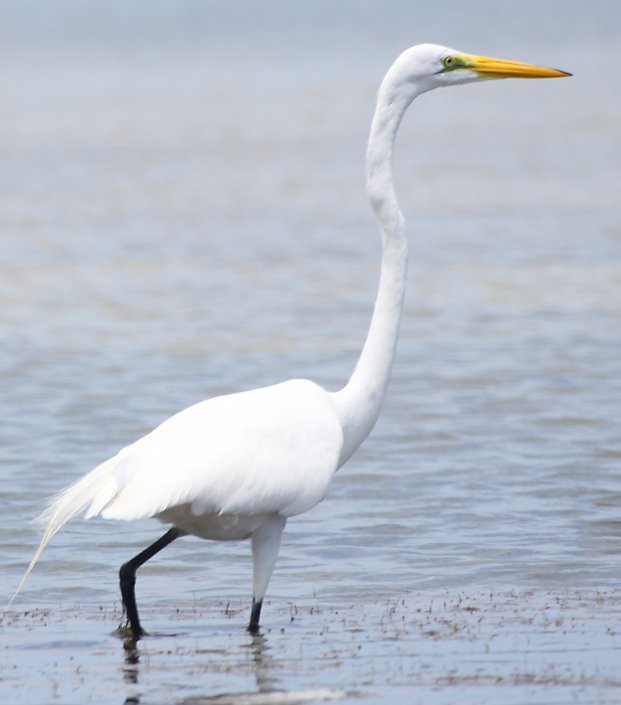
This is a great egret, which suffered the same hat-induced genocide as the snowy egret. Its long legs allow it to feed in deeper water than smaller egrets and herons, reducing the amount of competition between species. Among wading birds in this part of the world, it's second only to the great blue heron in size. |
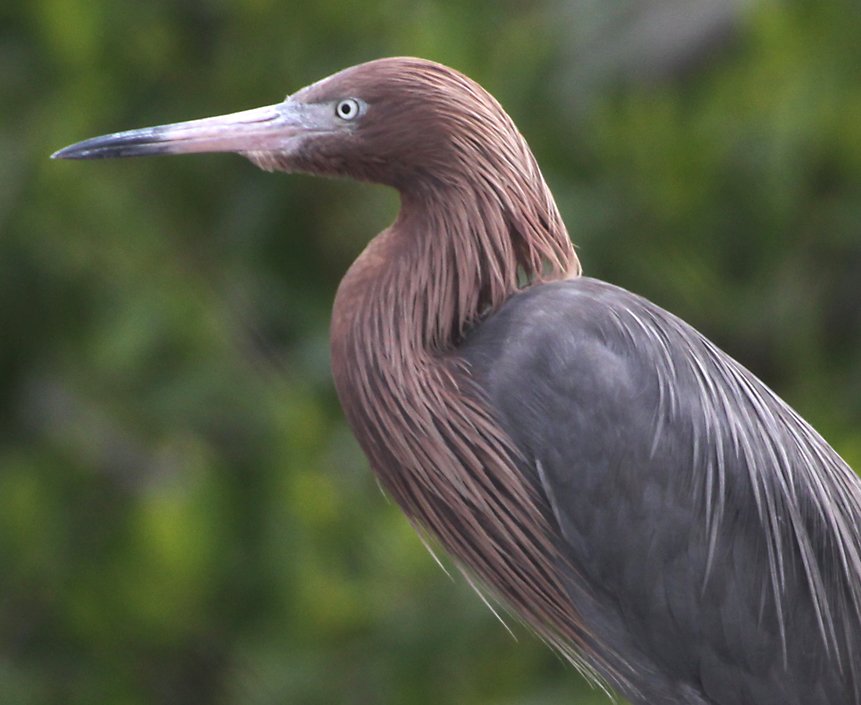
This is one of the few times I've seen reddish egrets, a small but very attractive member of the family. They share the snowy egret's habit of running after their food, but add a distinct twist by forming a canopy with its wings in front of its body. The shade which is created makes it easier to see its prey, and might also lure some prey like small fish into its reach. If this fails, then it uses its wings to flush its prey as it chases them down. There are two color forms, the typical one you see here and another with all white plumage, however both can be easily distinguished by their pink bills which have a dark tip. |
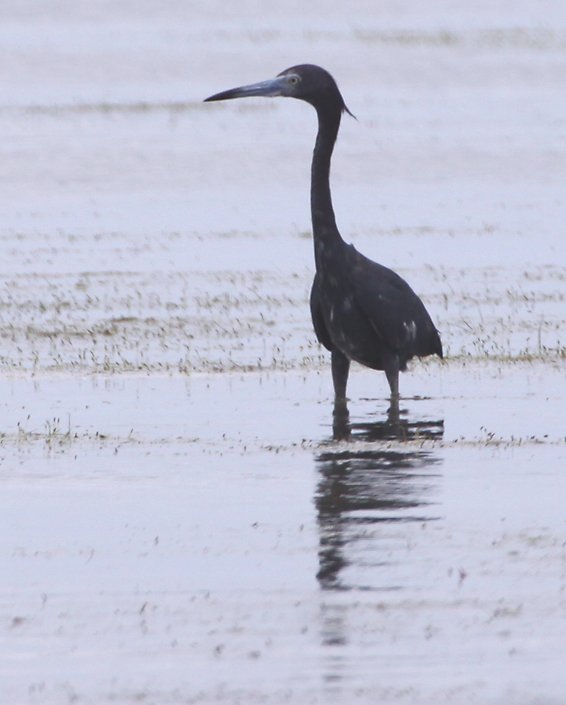
I've seen the little blue heron even less frequently than the reddish egret, and never gotten close enough to get a decent photo. |
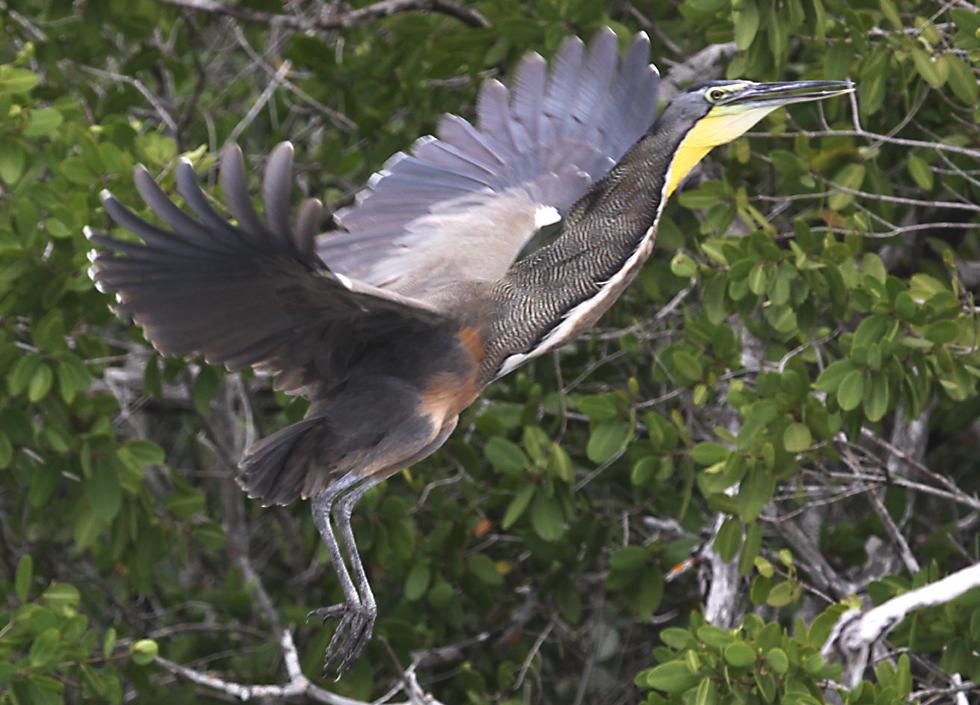
Bare throated tiger herons are one of the most spectacular members of the family. They don't live in the United States, but I saw them fairly often during this trip, not only at Rio Lagartos but also at Tikal in Guatemala and Monkey River in Belize. It's flight is sometimes described as "heavy", and with such an unbalanced looking neck and body it's no wonder! |
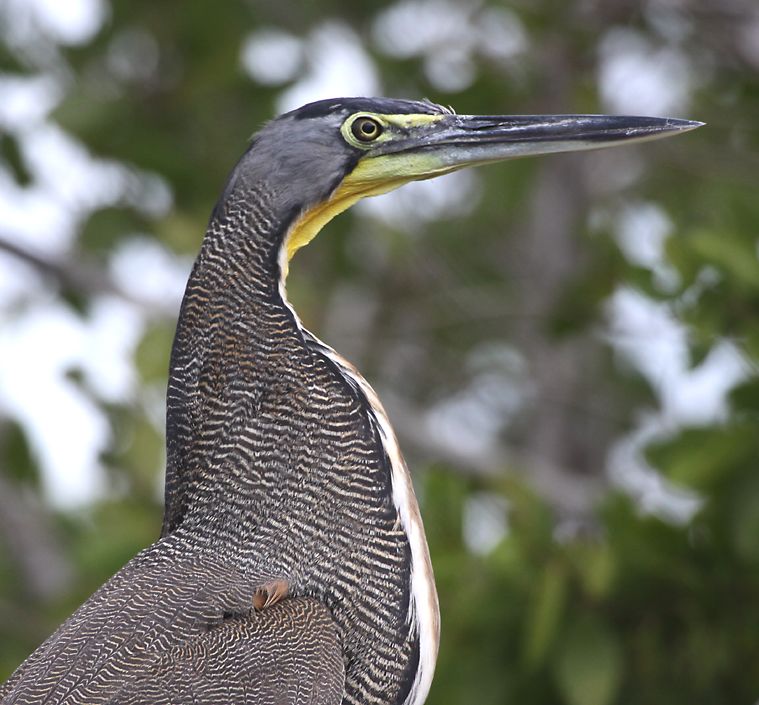
In spite of its somewhat ungainly shape, it's still a very attractive bird, with its finely grained "stripes" and the yellow throat which provides its name. |
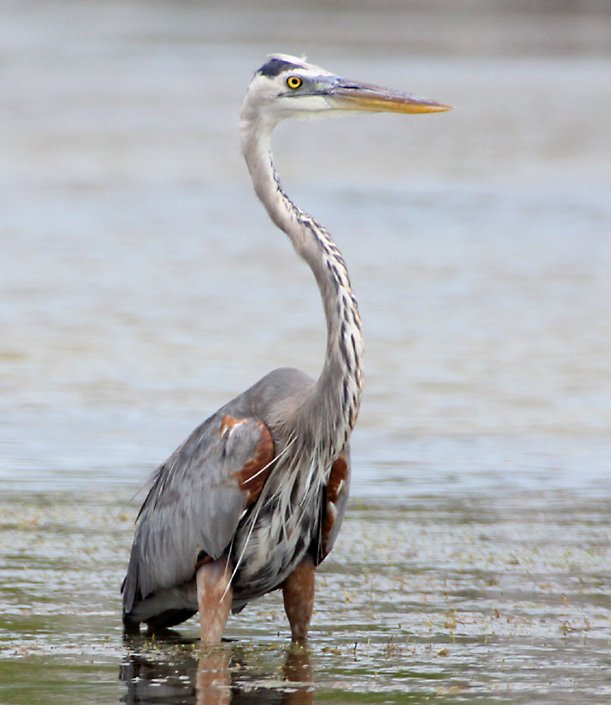
The great blue heron is at least the equal of the tiger heron in the appearance stakes. Not only is its plumage very attractive, it also has a much more slender and elegant shape. |
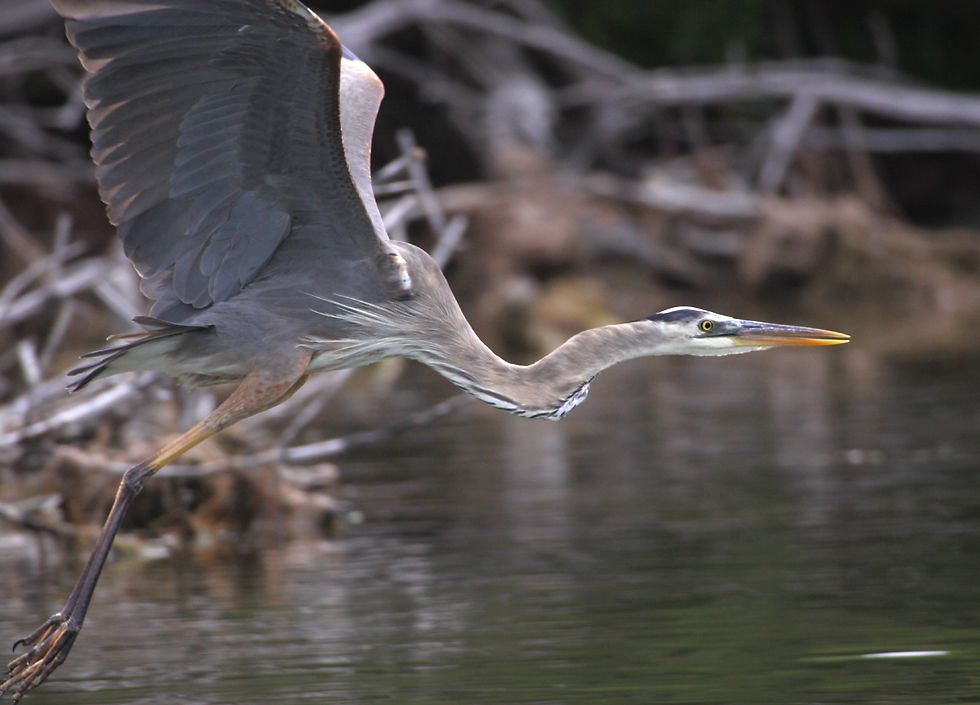
Even in flight it's much more obviously graceful. This is quite a common bird in wetlands from Canada all the way down to the northern parts of South America. |
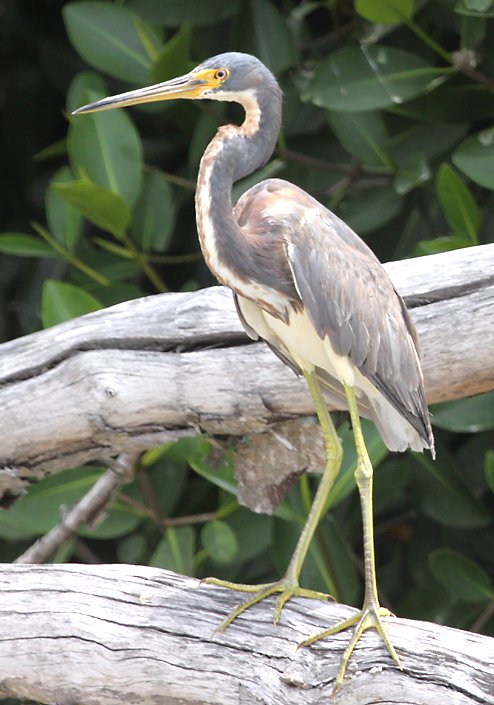
The tricolored heron is another species I haven't seen much of, though it's quite common in the southern states of the USA, where it used to be called the Louisiana heron. Although superficially similar to the great blue heron, it's quite a bit smaller and has an entirely white belly. Whereas the cattle egret is actually a heron, the tricolored heron is scientifically classified as an egret! |
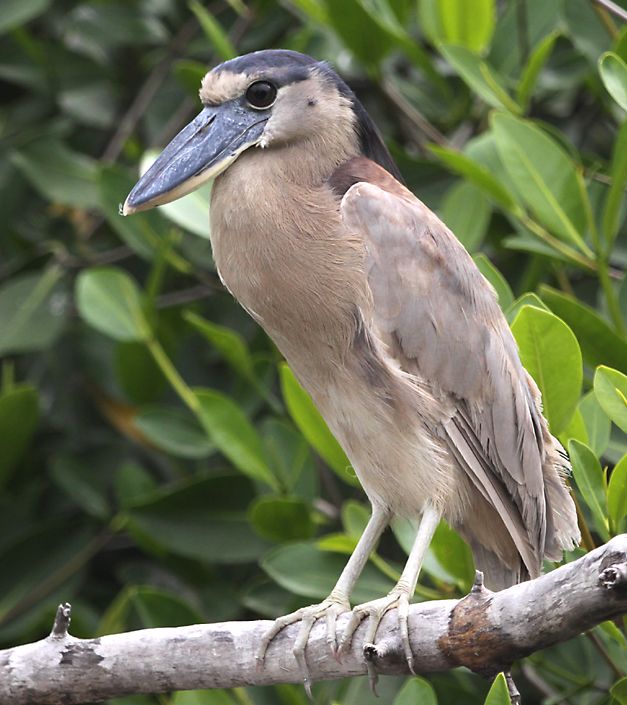
This peculiar looking creature is a juvenile boat-billed heron, though it's so atypical that it's often grouped on its own, rather than with most herons or egrets. It earns its name from its unusually wide beak. Southern Mexico is about as far north as they can be found, but their range extends south as far as the River Plate, which separates Uruguay and Argentina. |
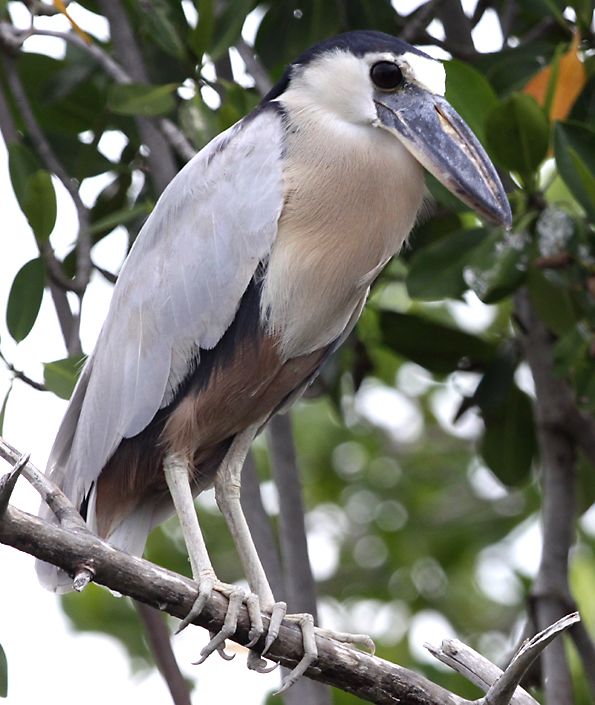
The adult boat-billed heron has lighter plumage than the immature birds, though it retains the dark head feathers and has darker brown on its belly. The large black eyes are almost as striking as the bill, and they mark this species as a nocturnal feeder. The birds I saw at Rio Lagartos were roosting up in the mangrove trees, and in some place there were 5 or 6 all in one small area. |

These birds are all very nice, but the real stars of Rio Lagartos are these American flamingos, which are closely related to the five other flamingo species. At one time almost all of the Yucatan's flamingos were at Rio Lagartos, but hurricane Isadora in 2002 did serious damage to the area, flattening large areas of mangroves and flooding the town with a meter or two of water. Soon afterwards many of the flamingos moved west to Celestun, which is where almost everybody goes to see them today. I didn't see another tourist during a full day at Rio Lagartos, but as I've already mentioned it seems at least as good as Celestun as a bird watching location. As well as the other advantages I've mentioned, you can also visit the Maya city of Ek Balam, which has some extraordinary relics and is much less crowded than other Maya sites in the area. I did go to the large city of Merida, which is the normal jumping-off spot for Celestun, but not only did I find the city's architecture disappointing, I was also told that there were very few flamingos at Celestun at the time I visited. |
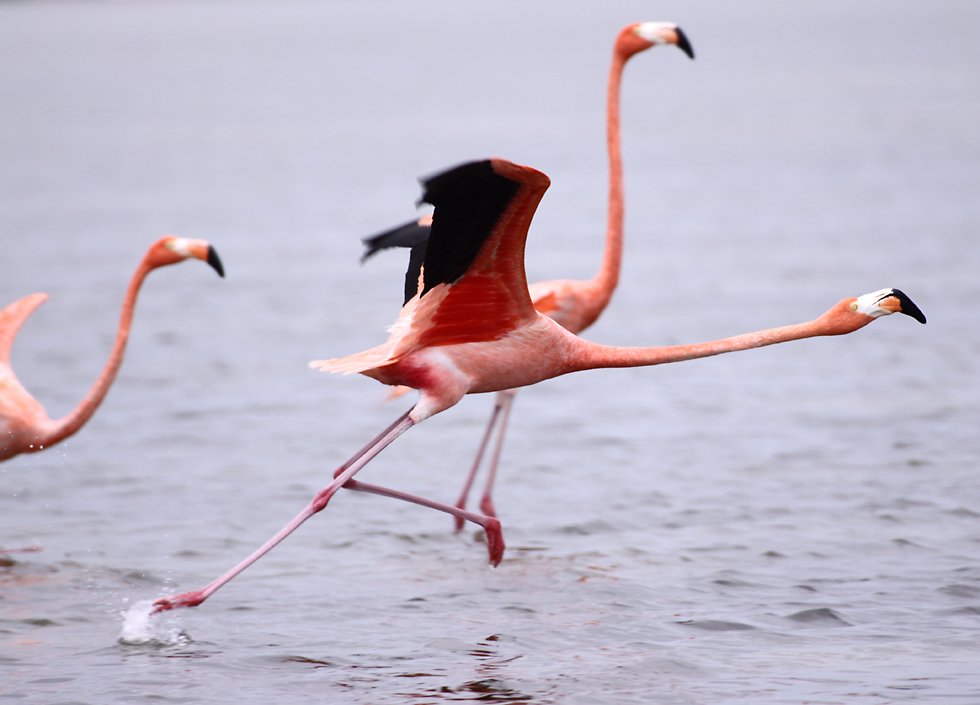
At 40 years, American flamingos are one of the longest-lived of all birds, and one of the tallest at around 140 centimeters high, though the greater flamingo does better on both scores, there's an individual in Adelaide zoo which is at least 75 years old, and adults reach 150 centimeters. The shape of their beak and their method of feeding is also very distinctive, they hold their head down and sweep from side to side, so that the top of the bill is at the bottom and the bottom is on top! |
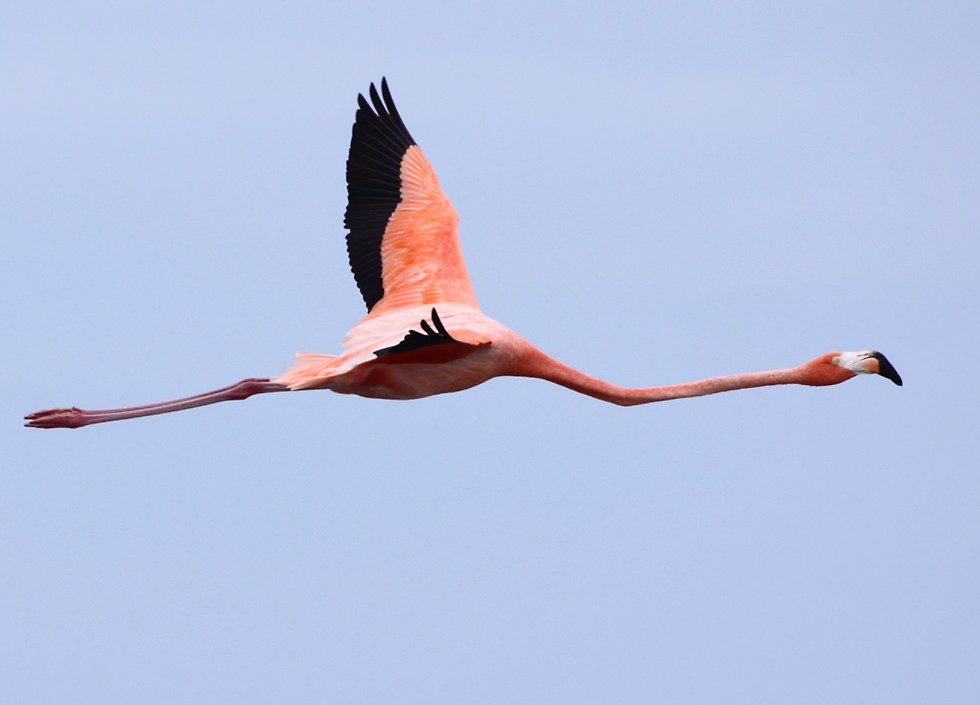
Oh, and did I mention that their bright pink and black plumage, and elegant shape make them a very beautiful bird to watch, whether wading, taking off or flying? American flamingos are the most flamboyantly colored of all the flamingo species, which are much paler. |